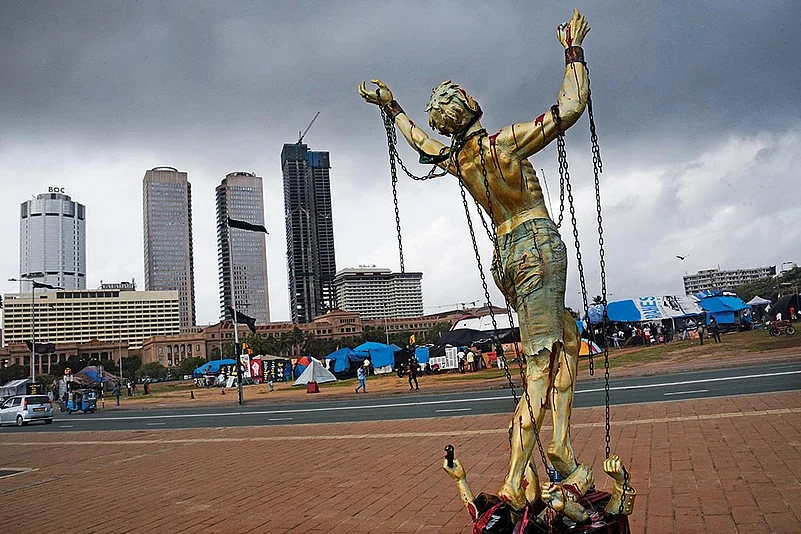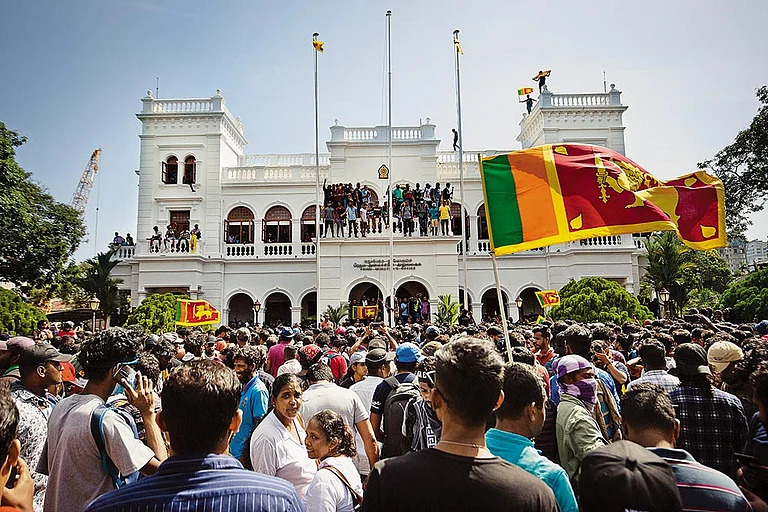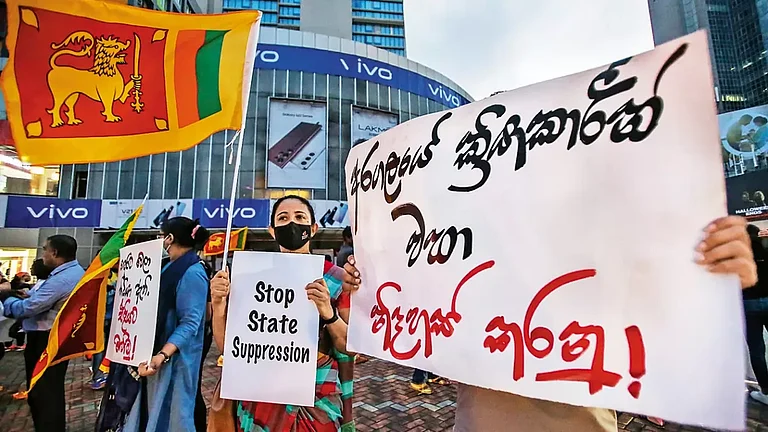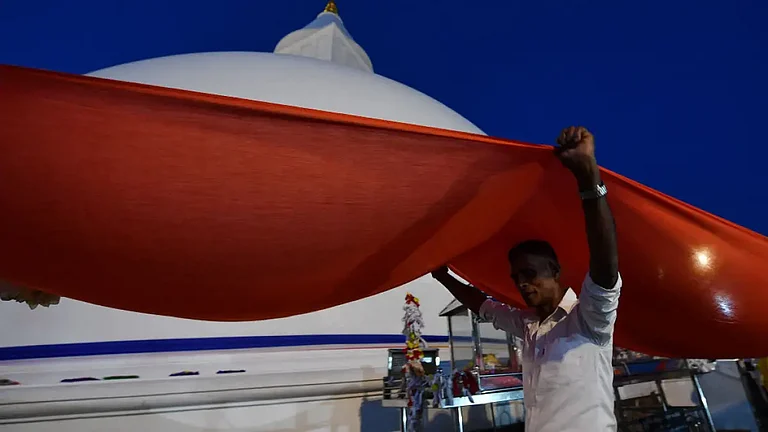Bangladesh protest is a reminder of Sri Lanka’s 2022 ‘Aragalaya’ (struggle), especially the departure or escape of the elected leaders amid people’s struggle for sovereignty.
Kusum Wijetilleke
Updated on: 23 August 2024

Island in Crisis: A view of the GotaGoGama camp during Sri Lanka’s economic crisis in 2022 Photo: Getty Images
We find ourselves in a moment where western countries, bastions of laissez-faire capitalism and global free trade, have turned to protectionism, most notably the electric vehicle tariffs recently imposed by the US and the European Union (EU) on Chinese exports.
This is not the first time. The 1974 Multi Fibre Arrangement (MFA) was aimed to protect the textile industries of developed nations, which had a long-lasting impact on some economies of Southeast Asia. In Sri Lanka, it would spawn the famous garment factory project of former President Ranasinghe Premadasa, part of what scholars like Saman Kelegama have called Sri Lanka’s “second wave of liberalisation”. To this day, Sri Lanka’s garment industry remains one of its top foreign exchange earners, a vital pillar of the economy.
The quota system imposed by the MFA also benefited Bangladesh, which began its industrialisation process in the early 1980s. Some 40 years later, despite relatively robust post-pandemic growth and macroeconomic stability, the last few weeks have revealed the underlying desperation of the Bangladeshi people, and there are certainly parallels to be drawn with Sri Lanka’s 2022 ‘Aragalaya’ (struggle), especially the departure or escape of democratically elected leaders. In both cases, the consolidated student body was central to the protest movements and over-represented at the sharp end of confrontations with security forces.

Protesters seeking the ouster of the acting president of Sri Lanka,
Ranil Wickremesinghe, on July 13, 2022 in Colombo Photo: Getty Images
In Sri Lanka, there is a tendency to breakdown the Aragalaya into two distinct phases—an idealistic, non-violent, people-centric, urban-cosmopolitan movement generating open-debate and progressive values; and, random acts of violence encouraged by political parties in an attempt to overthrow the State and take over its institutions. From the 2018 Yellow Vests movement in France to the pro-democracy protests in Hong Kong, peaceful protest movements can morph into violent uprisings. The fact of a movement devolving into violence should not in itself de-legitimise the movement or its ethos.
In Sri Lanka, there is a tendency to breakdown the Aragalaya into two distinct phases—an idealistic, non-violent, people-centric, urban-cosmopolitan movement generating open-debate and progressive values; and, random acts of violence encouraged by political parties in an attempt to overthrow the State and take over its institutions. From the 2018 Yellow Vests movement in France to the pro-democracy protests in Hong Kong, peaceful protest movements can morph into violent uprisings. The fact of a movement devolving into violence should not in itself de-legitimise the movement or its ethos.

India, A Convenient Scapegoat In South Asian Politics
In many ways, there seems to be a more complex set of circumstances that led to the violence witnessed in Bangladesh—a staggering single-day death toll of 97. Compare this with the death toll in Sri Lanka over the 7-8 month period of the protest movement: 10 protestors, one Member of Parliament, one state official and one policeman.
Both Sri Lanka and Bangladesh suffer from an under-diversified and under-developed export sector, with a very low proportion of their respective exports being categorised as ‘high technology’.
The economic reality in Sri Lanka was, however, much worse than Bangladesh. At the peak of the crisis, Sri Lanka had among the top five highest rates of inflation in the world, and was among the top three most acute currency depreciations. Sri Lanka’s debt to GDP was over 125 per cent, external debt to GDP was over 75 per cent.
When the Gotabaya Rajapaksa government took over, Sri Lanka’s treasury had over $7.5 billion in reserves; a significant buffer. From 2019 to the end 2021, Sri Lanka’s foreign exchange reserves collapsed by $6 billion or 79 per cent. In contrast, many regional peers saw increases in their overall reserves during the same period, with Bangladesh being one of the better performers increasing its reserves by 41 per cent.
Bangladesh presents a case study for Sri Lanka on not only how to avoid the pitfalls of late-stage industrialisation, but also reveals the contradictions of the neo-liberal era. Bangladesh is a poster boy for the success of the free trade regime; GDP per capita has grown and the economy has developed as multinationals shifted manufacturing plants to take advantage of lower labour costs. Despite the burgeoning garment sector, like Sri Lanka, Bangladesh also still depends on remittances from its migrant worker population and has an agricultural sector dependent on government subsidies.
Both Sri Lanka and Bangladesh suffer from an under-diversified and under-developed export sector, with a very low proportion of their respective exports being categorised as ‘high technology’. Like Sri Lanka, Bangladesh too suffers from low tax revenues with tax to GDP in single digits at around eight per cent in 2022.
Despite these similarities, the two countries have very different debt profiles. An International Monetary Fund (IMF) review in November 2023 stated that “Bangladesh remains at a low risk of external and overall debt distress”. Critically, Bangladesh has one of the highest rates of extreme poverty in the region—around 10 per cent of the population lives in near destitution, while it also scores poorly on the Multidimensional Poverty Index. A recent report suggested that some 28 per cent of children under five are stunted, indicating chronic under-nutrition. The contributing factors for this situation are rising income inequality, rural-urban divide and the COVID-19 pandemic that exacerbated these dynamics.

Colombo Diary: Unsettled Ease
Bangladesh and Sri Lanka have both failed to invest in public services, education, health and social assistance. Even as their economies grew and the per capita GDP increased, the notoriously-elusive ‘trickle-down’ did not materialise.
Among the lower-middle income countries, Sri Lanka is a low spender on social expenditure (health, education and social assistance): at around five per cent of GDP, while Bangladesh spends under three per cent. Sri Lanka and Bangladesh both spend around 0.7 per cent of GDP on social assistance, which is lower than the South Asian average, which is itself lower than the global average. Sri Lanka and Bangladesh are also among the lowest spending countries per student on primary and secondary education.
The Aragalaya was a reaction, not just to the failures of the political class, but also to the lack of accountability. The upcoming cycle of elections will be an opportunity for the Sri Lankan people to demonstrate their frustrations at the political classes through the ballot. The outcome of the election will only add to the post-mortem of Sri Lanka’s mass protest movement. Has the average Sri Lankan voter simply moved on from “systemic change”? The very fact that the Rajapaksa scion, Namal, is contesting the upcoming Presidential election is a statement from a political dynasty that just two years ago needed to flee abroad for their safety.
The elections will also answer questions related to the incumbent president’s handling of the economic crisis, the popularity of Sri Lanka’s Marxist-Leninist Janatha Vimukthi Peramuna (JVP) party, and whether the people view the main opposition party, the liberal Samagi Jana Balawegaya (SJB), as a desirable alternative. The main election dynamic might well be a protest vote against the Rajapaksa political dynasty, but it could also reveal dissatisfaction with the political classes as a whole, if the JVP grows its voter base significantly, as some pollsters suggest they might.
The protests in Bangladesh emanated partly from a longstanding quota system for government jobs. Sri Lanka is also undergoing a period of prolonged stagnation alongside a decimation of its middle class.
Power cuts and fuel queues made life unlivable for the middle class, broadening the Aragalaya’s base of support. As the protests intensified, it gave a tacit permission to the upper-middle classes to join in. Soon, it was not uncommon to see CEOs and other industry titans walking the streets of Galle Face Road in Colombo alongside protesters and activists. Indeed, the central streets along the main business district became a sort of symbolic shrine to the movement, a place to mark the people’s struggle. GotaGoGama or GGG was the epicentre of the wider Aragalaya movement, and in many ways, the star attraction.
However, the Aragalaya was not born on the Galle Face Road. Instead, it was the farming community in the far-flung corners of the country that first began protesting en masse as early as in mid-2021 over the government’s organic fertiliser policy. The currency collapse resulting from the free-float of the Rupee saw teachers, nurses and a number of civil servants join the struggle as the cost of living skyrocketed. The coalescing of the working classes, farmers and peasantry—the traditional Mahinda Rajapaksa base—should have been a warning.
At its peak, during its most expansive ideological formation, the Aragalaya came to encapsulate a mood for deep, structural changes in how Sri Lanka is governed. There were strains that called for constitutional reform and the inclusion of a people’s chamber in Sri Lanka’s governance structure. A significant section of the Aragalaya also called for the abolishing of the Executive Presidency.

Sri Lanka: Hope May Be A Firefly But It Has Replaced Darkness Of Last Couple Of Months
The Sri Lankan Aragalaya was not a uniform, singular animal. Like all movements, it was a collection of moving parts, some working in coordination, others dancing to their own tune. It is fascinating that we celebrate the diverse and eclectic nature of the Aragalaya, but find it difficult to reconcile its many faces when they show up bruised and bloodied.
Critics of the Aragalaya insist that it was a fleeting, idealistic but ultimately incoherent movement which devolved into violence, alienating the middle classes. The violence linked the Aragalaya to Leftist political organisations such as the Inter University Students’ Federation (IUSF) and its political arm, the Frontline Socialist Party (FSP). The JVP’s own history of violence linked it to less desirable aspects of the Aragalaya; the attempted insurrections in the 1970s and 1980s still causes the average Sri Lankan to disengage from any form of overt ‘Leftism’.
The wider base of middle and lower-middle classes that were integral to the legitimacy of the movement seemed dismayed by the violence from both sides. By the time Ranil Wickremesinghe was elected President through a Parliamentary vote in July 2022, the wider Aragalaya had been in place for over four months, but the energy was beginning to dissipate. The wider community began to grow suspicious of the more revolutionary streak the movement was starting to display; a brutal crackdown by the Wickremesinghe government also led to some part of the movement going underground.
With regards to violence and dissent, philosopher Noam Chomsky noted in 1967 that “any rational person would agree that violence is not legitimate unless the consequences of such action are to eliminate a still greater evil”. Whereas historian Hannah Arendt viewed violence from the perspective of ‘political legitimacy’, there are nuances that were lost on the wider participants of the Aragalaya who simply sought a return to normalcy.
The protests in Bangladesh emanated partly from a longstanding quota system for government jobs, indicating that the Bangladeshi people perceive a lack of meritocracy in a system that for decades has under-invested in their futures.
Sri Lanka is also undergoing a period of prolonged stagnation alongside a decimation of its middle class. In both countries, protest movements were a direct reaction to the dilution of people’s sovereignty. Due to being Indo-European languages from different branches—with influences from Sanskrit and Pali—Bengali and Sinhalese have many similar sounding words with similar meanings. ‘Jatiya’ in Bengali and ‘Jatika’ in Sinhalese both allude to the word ‘national’; a characteristic of a nation.
The question remains: what good is a nation if it cannot live up to the hopes and dreams of its people?
(Views expressed are personal)
Kusum Wijetilleke is a political commentator and foreign affairs analyst
(This appeared in the print as 'Bruised And Bloodied')
Among the lower-middle income countries, Sri Lanka is a low spender on social expenditure (health, education and social assistance): at around five per cent of GDP, while Bangladesh spends under three per cent. Sri Lanka and Bangladesh both spend around 0.7 per cent of GDP on social assistance, which is lower than the South Asian average, which is itself lower than the global average. Sri Lanka and Bangladesh are also among the lowest spending countries per student on primary and secondary education.
The Aragalaya was a reaction, not just to the failures of the political class, but also to the lack of accountability. The upcoming cycle of elections will be an opportunity for the Sri Lankan people to demonstrate their frustrations at the political classes through the ballot. The outcome of the election will only add to the post-mortem of Sri Lanka’s mass protest movement. Has the average Sri Lankan voter simply moved on from “systemic change”? The very fact that the Rajapaksa scion, Namal, is contesting the upcoming Presidential election is a statement from a political dynasty that just two years ago needed to flee abroad for their safety.
The elections will also answer questions related to the incumbent president’s handling of the economic crisis, the popularity of Sri Lanka’s Marxist-Leninist Janatha Vimukthi Peramuna (JVP) party, and whether the people view the main opposition party, the liberal Samagi Jana Balawegaya (SJB), as a desirable alternative. The main election dynamic might well be a protest vote against the Rajapaksa political dynasty, but it could also reveal dissatisfaction with the political classes as a whole, if the JVP grows its voter base significantly, as some pollsters suggest they might.
The protests in Bangladesh emanated partly from a longstanding quota system for government jobs. Sri Lanka is also undergoing a period of prolonged stagnation alongside a decimation of its middle class.
Power cuts and fuel queues made life unlivable for the middle class, broadening the Aragalaya’s base of support. As the protests intensified, it gave a tacit permission to the upper-middle classes to join in. Soon, it was not uncommon to see CEOs and other industry titans walking the streets of Galle Face Road in Colombo alongside protesters and activists. Indeed, the central streets along the main business district became a sort of symbolic shrine to the movement, a place to mark the people’s struggle. GotaGoGama or GGG was the epicentre of the wider Aragalaya movement, and in many ways, the star attraction.
However, the Aragalaya was not born on the Galle Face Road. Instead, it was the farming community in the far-flung corners of the country that first began protesting en masse as early as in mid-2021 over the government’s organic fertiliser policy. The currency collapse resulting from the free-float of the Rupee saw teachers, nurses and a number of civil servants join the struggle as the cost of living skyrocketed. The coalescing of the working classes, farmers and peasantry—the traditional Mahinda Rajapaksa base—should have been a warning.
At its peak, during its most expansive ideological formation, the Aragalaya came to encapsulate a mood for deep, structural changes in how Sri Lanka is governed. There were strains that called for constitutional reform and the inclusion of a people’s chamber in Sri Lanka’s governance structure. A significant section of the Aragalaya also called for the abolishing of the Executive Presidency.

Sri Lanka: Hope May Be A Firefly But It Has Replaced Darkness Of Last Couple Of Months
The Sri Lankan Aragalaya was not a uniform, singular animal. Like all movements, it was a collection of moving parts, some working in coordination, others dancing to their own tune. It is fascinating that we celebrate the diverse and eclectic nature of the Aragalaya, but find it difficult to reconcile its many faces when they show up bruised and bloodied.
Critics of the Aragalaya insist that it was a fleeting, idealistic but ultimately incoherent movement which devolved into violence, alienating the middle classes. The violence linked the Aragalaya to Leftist political organisations such as the Inter University Students’ Federation (IUSF) and its political arm, the Frontline Socialist Party (FSP). The JVP’s own history of violence linked it to less desirable aspects of the Aragalaya; the attempted insurrections in the 1970s and 1980s still causes the average Sri Lankan to disengage from any form of overt ‘Leftism’.
The wider base of middle and lower-middle classes that were integral to the legitimacy of the movement seemed dismayed by the violence from both sides. By the time Ranil Wickremesinghe was elected President through a Parliamentary vote in July 2022, the wider Aragalaya had been in place for over four months, but the energy was beginning to dissipate. The wider community began to grow suspicious of the more revolutionary streak the movement was starting to display; a brutal crackdown by the Wickremesinghe government also led to some part of the movement going underground.
With regards to violence and dissent, philosopher Noam Chomsky noted in 1967 that “any rational person would agree that violence is not legitimate unless the consequences of such action are to eliminate a still greater evil”. Whereas historian Hannah Arendt viewed violence from the perspective of ‘political legitimacy’, there are nuances that were lost on the wider participants of the Aragalaya who simply sought a return to normalcy.
The protests in Bangladesh emanated partly from a longstanding quota system for government jobs, indicating that the Bangladeshi people perceive a lack of meritocracy in a system that for decades has under-invested in their futures.
Sri Lanka is also undergoing a period of prolonged stagnation alongside a decimation of its middle class. In both countries, protest movements were a direct reaction to the dilution of people’s sovereignty. Due to being Indo-European languages from different branches—with influences from Sanskrit and Pali—Bengali and Sinhalese have many similar sounding words with similar meanings. ‘Jatiya’ in Bengali and ‘Jatika’ in Sinhalese both allude to the word ‘national’; a characteristic of a nation.
The question remains: what good is a nation if it cannot live up to the hopes and dreams of its people?
(Views expressed are personal)
Kusum Wijetilleke is a political commentator and foreign affairs analyst
(This appeared in the print as 'Bruised And Bloodied')
No comments:
Post a Comment